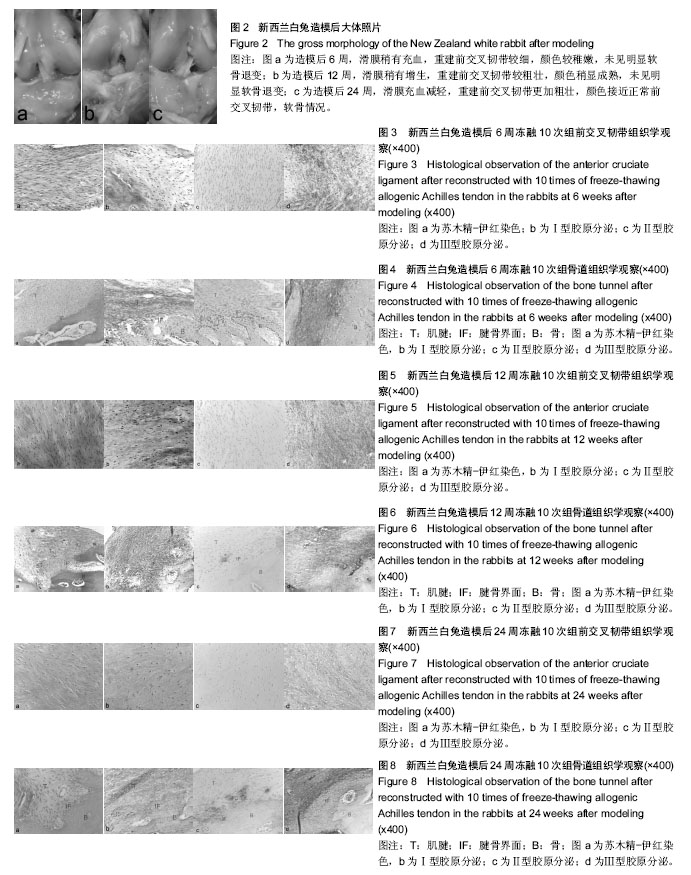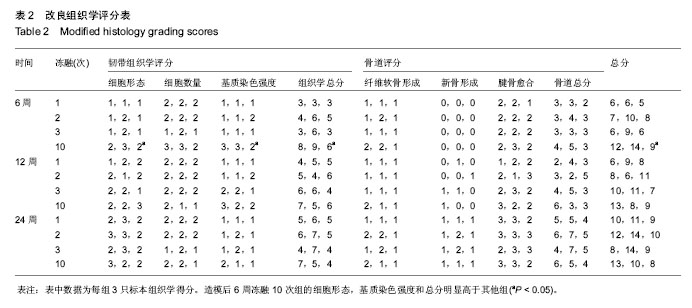| [1] Kuhn MA, Ross G.Allografts in the Treatment of Anterior Cruciate Ligament Injuries. Sports Med Arthrosc.2007;15 (3):133-138.[2] Arnoczky SP, Warren RF, Ashlock M. Replacement of the anterior cruciate ligament using a patellar tendon allograft. An experimental study. J Bone Joint Surg Am.1986;68(3):376-385.[3] 江东,余家阔,敖英芳,等. 4例同种异体半月板移植术后中期随访报告[J].中国微创外科杂志2009, 9(6):545-548.[4] Miller SL, Gladstone JN. Graft selection in anterior cruciate ligament reconstruction. OrthopClin North Am.2002;33: 675-683[5] Mahirogullari M, Ferguson CM, et al. Freeze-dried allografts for anterior cruciate ligament reconstruction.Clin Sports Med. 2007;26(4):625-637. [6] Gibbons MJ, Butler DL, Grood ES, et al.Effects of gamma irradiation on the initial mechanical and material properties of goat bone- patellar tendon-bone allografts. J Orthop Res. 1991;9(2):209-218[7] 吴延平,王英振,余家阔,等.反复冻融处理同种异体移植兔跟腱组织学及生物力学变化[J].中国组织工程研究与临床康复, 2009, 13(5):816-819.[8] 关于善待实验动物的指导性意见.中华人民共和国科学技术部文件,国科发财字[2006]398号.[9] Benjamin M, Evans EJ, Copp L.The histology of tendon attachments to bone in man. J Anat.1986;149(12):89-100.[10] Noyes FR, Butler DL, Grood ES,et al. Biomechanicalanalysis of human ligament grafts used in knee-ligament repairsand reconstructions. J Bone Joint Surg Am.1984; 66A:344-352[11] 龚熹,敖英芳,于长隆.自体髌腱与自体四股腘绳肌腱重建前交叉韧带对髌股关节软骨影响的关节镜对比观察研究[J]. 中国运动医学杂志,2007,26(3):271-274[12] Jiakuo Yu, Paessler HH. Relationship between tunnel widening and different rehabilitation procedures after ACL reconstruction with quadrupled hamstring tendons. Chinese Medical Journal.2005;118(4): 320-326.[13] 马广文,余家阔,李军,等.对2例膝关节前交叉韧带部分断裂与重建的初步临床观察.中国运动医学杂志,2006, 25(6):713, 715. [14] Avery FL.(2004) The sports medicine centre ACL graft options [online]. Available: http://www.orthoassociates.com/ ACL_grafts.htm [accessed 20.7.2004][15] Sherman OH, Banffy MB.Anterior cruciate ligamentreconstruction: which graft is best? Arthroscopy. 2004;20(9):974-80.[16] Fahey M,IndelicatoPA.Bone tunnel enlargement afteranterior cruciate ligament replacement. Am J Sports Med.1994;22(3): 410-414.[17] Frank CB, Jackson DW.The science of reconstruction ofthe anterior cruciate ligament—current concepts review.J Bone Joint Surg Am.1997;79A:1556-1576.[18] Dustmann M, Schmidt T, Gangey I, et al.The extracellular remodeling offree-soft-tissue autograftsand allografts for reconstruction of the anterior cruciate ligament:a comparison study in a sheep model.KneeSurg Sports Traumatol Arthrosc. 2008;16:360-369.[19] Sharpey W, Ellis GV. Elements of anatomy. London: Walton and Moberly.1856;Voll: Ed6.[20] Rodeo SA, Arnoczky SP, Torzilli PA, et al.Tendon-healing in a bone tunnel. A biomechanical and histological study in the dog.J Bone Joint Surg Am.1993;75(12):1795-1803.[21] Panni AS, Milano G, Lucania L, et al. Graft healing after anterior cruciate ligament reconstruction in rabbits. Clin Orthop Relat Res.1997;10(343):203-212. |
.jpg)


.jpg)
.jpg)
.jpg)